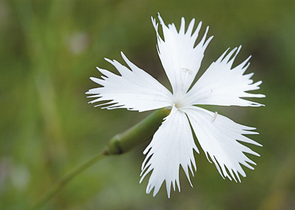Nature Conservation 3/2010 — 22. 6. 2010 — Research, Surveys and Data Management — Print article in pdf
The Bohemian Sand Pink (Dianthus arenarius subsp. bohemicus) – Plan is running

The Bohemian Sand Pink (Dianthus arenarius bohemicus) is an approximately 15 cm tall perennial with white flowers growing in dense clusters.
It is an endemic species of Pleistocene gravel-sand terraces near the town of Roudnice nad Labem (North Bohemia). In the late 1990s there had been only two hundred old clusters in the Kleneč National Nature Monument (NNM) and the only cluster near the village of Kyškovice at a substitute site. Preservation of the species for Czech flora was at least uncertain. In 1999 bulldozers removed humus level in part of the Kleneč NNM to gravelous sand substrate. This revolutionary intervention has opened a way to save the Bohemian Sand Pink for world’s flora. Many little seedlings appeared on uncovered sand substrate the following year. The population has been still growing there. Later, in 2008, the Action Plan for Bohemian Sand Pink in the Czech Republic was approved by the Ministry of the Environment of the Czech Republic. The objective of the Action Plan for Dianthus arenariussubsp. bohemicusis to ensure long-term stability of a Bohemian Sand Pink (hereinafter BSP) population at the only original site – the Kleneč NNM and to establish a stable population at the substitute site near Kyškovice.
There are six main areas of supporting measures:
1.Habitat management includes annual mowing, removing of competitive natural tree seedlings and expansive grasses such as the Wood Small-reed (Calamagrostis epigejos), disturbances of soil surface and also mechanized removing of humus layer. 2.Species management includes sowing and deposition of seeds in a genetic seed bank. 3.Monitoring involves monitoring of populations, soil conditions and vegetation. 4.Research measures propose study of a) BSP’s population biology, b) effect of substrate on morphological variability in the BSP, c) genetic variability in BSP’s populations, d) relation between the BSP and phytophagous invertebrates, e) occurrence of insects in the Kleneč NNM. 5.Education and promotion of the species and its Action Plan. 6.Other measures involve mainly providing the substitute site near Kyškovice with legal protection.
Up till now, implementation of the Action Plan has brought some positive points:
- Mechanized removal of humus layer was repeated in 2009.
- Regular management was modified according to demands of insect fauna found in a survey carried out in 2008–2009, although BSP’s conservation has been of the prime interest.
- Mystery of pinkflowerig plants has been solved. These plants were confirmed as interspecies hybrids.
- Research in many areas that are important for practical conservation has started.

